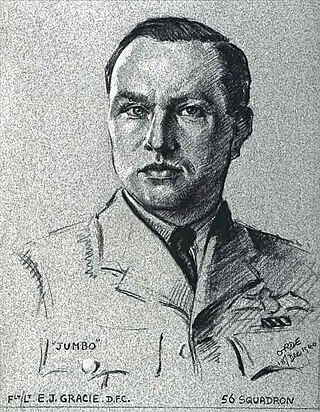On the commencement of the Second World War, No. 87 Squadron was sent to France as part of No. 60 Wing, the Air Component of the British Expeditionary Force. Based at Lille for most of the Phoney War, the squadron patrolled along the front lines and sought to intercept Luftwaffe aircraft. In April, the squadron moved to Le Touquet. It was flying from here that Cock achieved his first claimed aerial victory on 10 April, a Heinkel He 111 medium bomber that was shot down into the sea.
Battle of Britain
At Debden, the squadron underwent a refit and became operational again on 21 June. At the start of July, the squadron moved to Exeter, as part of No. 10 Group which defended the south-west coast of England. It remained here for the duration of the Battle of Britain. On 10 July, he damaged a Dornier Do 215 medium bomber. A flight from No. 87 Squadron was also involved in night fighting and on the night of 26 July, Cock shot down a He 111 about 1 mi (1.6 km) to the east of Portland.
On 11 August the squadron was scrambled to intercept Ju 88 bombers that had just attacked fuel storage tanks at Portland. Cock destroyed a Bf 109 as he sought to catch the bombers. He engaged and destroyed one Ju 88 and probably destroyed another. He also claimed a Bf 110 as a probable but his Hurricane was damaged by cannon and machine gun fire. Slightly wounded in the shoulder, he bailed out of his aircraft with some difficulty, having briefly become stuck. As he descended under his parachute, a Bf 109 fired on him. Although he was not hurt, a number of cords connecting the parachute to his harness were severed. Another RAF fighter dealt with the Bf 109, leaving Cock to land in the English Channel. Discarding his boots and trousers he swam to shore. This incident resulted in him being placed on a month's leave.
By the time of Cock's return to No. 87 Squadron the following month, the Luftwaffe was attacking London and aircraft factories in the south of England, some being in the area of No. 10 Group. In the interim, he had been promoted to flying officer. [10] On 26 September, while flying over Sidmouth, he destroyed a Ju 88 and damaged a Bf 109. Two days later, while intercepting one of the last daylight raids mounted by the Luftwaffe, an attack on a Yeovil aircraft factory, he shot down another Ju 88 and probably destroyed a Bf 109. During the engagement with the Ju 88, he came close to colliding with it.
In early October, the Luftwaffe began using Bf 109s as fighter-bombers, making high speed dashes on targets in the south of England. On 10 October, Cock engaged and probably destroyed a Bf 109 over Portland, his last aerial victory. Later in the month, on 24 October, he was involved in a collision; patrolling at 3,000 ft (910 m) the engine of his Hurricane failed and the sudden deceleration caught out the pilot of the following Hurricane, which crashed into the rear fuselage of Cock's aircraft. Cock was able to make a forced landing but the other pilot was killed. The following day, Cock was awarded the Distinguished Flying Cross (DFC); the citation, published in The London Gazette , read
This officer has destroyed seven enemy aircraft. In August, 1940, when in action against a large formation of enemy aircraft, he attacked and destroyed a Junkers 88. During this combat he was attacked from below and his aircraft caught fire. Though wounded, he escaped by parachute and fell into the sea, but saved himself by swimming ashore. Flying Officer Cock has shown magnificent courage and initiative against overwhelming odds.
—
London Gazette, No. 34978, 25 October [14]
Later service
In November No. 87 Squadron moved to Colerne and began to concentrate on night fighting. The following month, Cock was posted to No. 2 Central Flying School to train as a flight instructor and early the following year was sent to No. 9 Flying Training School. He remained here until August 1941, when he was posted to No. 28 Elementary Flying Training School. Soon afterwards he was promoted to flight lieutenant. In July 1942, he returned to operational flying with a posting to No. 453 Squadron, a new Australian fighter squadron, as a flight leader. The squadron, based at Drem and equipped with Supermarine Spitfire fighters, was engaged in convoy patrols and interception duties. It moved south to Hornchurch in September but Cock was then sent to the Central Gunnery School (CGS).
After completing his course at the CGS, Cock was briefly attached to an American squadron, the 93rd Fighter-Interceptor Squadron, in October before being transferred to No. 222 Squadron, based at Ayr in Scotland. In November, he was sent to Australia on attachment to the Royal Australian Air Force, initially based in Sydney. In May 1943 he was posted to No. 1 Fighter Wing, based at Darwin as part of the fighter defences protecting the north of Australia from aerial attacks by the Japanese. He worked on improving the gunnery skills of the fighter pilots and also flew Spitfires as a supernumerary pilot with No. 54 Squadron, a British unit serving at Darwin. At the start of the following year, he was promoted to temporary squadron leader. [18] Later in 1944, he returned to England and in September was posted to No. 3 Squadron, which operated Hawker Tempest fighters as bomber escorts and ground support.
From April to August 1945, Cock was based in Khartoum, in east Africa, where he tested the Hawker Tempest II. He ended the war credited with the destruction of 10 German aircraft, and a share in another shot down. He also had one unconfirmed aircraft destroyed, four probably destroyed and five damaged.















